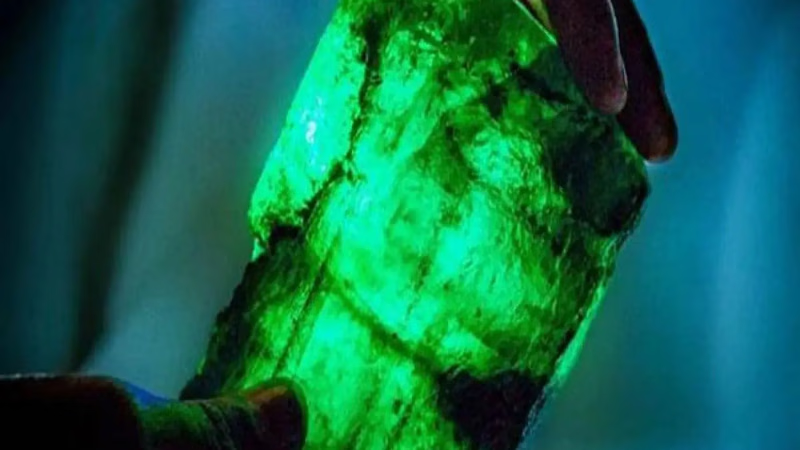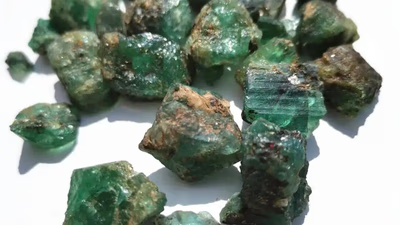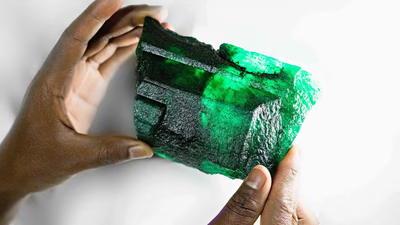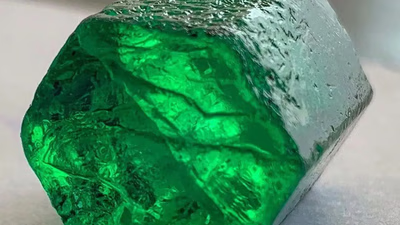
Emerald and green beryl showcase stunning green hues.
Emerald is the green variety of beryl that exhibits a distinct green color. It is known for its rich, vibrant green hues, ranging from light to dark shades. The color of emerald is influenced by the presence of trace amounts of chromium, vanadium, and iron in the crystal structure. Green beryl, on the other hand, is a more general term used to describe beryl gemstones with a green color that does not meet the specific criteria for emerald. Green beryl typically has a lighter or less intense green color compared to emerald. The color of green beryl can vary from pale green to a medium-green hue.
Emeralds are highly sought after and can command significant prices, especially for fine-quality stones with intense green color, good clarity, and larger carat weights. Emeralds are associated with prestige, rarity, and historical significance, making them highly desirable to collectors and gem enthusiasts. Green beryl, while still attractive, does not carry the same prestige or value as emerald. It is generally considered a more affordable option for individuals who appreciate the green color but do not require the specific characteristics or investment value associated with emeralds.
Due to the high pressure during the formation of emeralds in the ground and difficult extraction conditions, natural emeralds may have many fractures and cracks, which is why from the past until now, to cover the cracks, put it in a liquid like a special oil and improve the emerald. Emerald lubrication is a global process and about 90% of the emeralds on the market are oiled, but you should note that our emerald crystals must have surface-breaking fractures in order for oil to enter. When rough emerald is extracted from the mine, it is thrown into barrels of oil, and this oil facilitates the cutting process.
A combination of vanadium and chromium produces emerald color, and the more iron in emerald, the bluer it will be. Today, according to the GIA Emerald Institute of Gemology, green braille has a high degree of color density and a medium or dark tone or darkness, and in terms of color type (Hue), the best color is green and bluish green. The color of emerald is almost constant and does not change in the face of artificial or natural light like the sun and only changes at a temperature of 700 to 800 degrees Celsius. If your emerald ring loses its beauty and shine as a result of contact with detergents, you should put it in a thin layer of colorless oil. To increase the quality of the paint and prevent light reflection in its cracks, it is usually impregnated with oil or wax, epoxy or plastic.
Emerald is a well-established and highly valued gemstone. It has its own grading standards and market expectations based on color, clarity, and other factors. Emeralds are graded primarily based on their color, clarity, carat weight, and cut quality. The most sought-after emeralds possess an intense, vivid green color with high clarity and minimal inclusions. Green beryl, while visually similar to emerald, is generally considered a lesser valuable variety. It does not have the same strict grading standards or market demand as emerald. Green beryl is often appreciated for its affordability and can be a suitable alternative for those seeking a green gemstone at a lower price point.
-

Emeralds, a rare variety of beryl, are distinguished by their vibrant green color, attributed to chromium and vanadium. Their scarcity is due to the unique geological conditions required for their formation. The value of emeralds is primarily determined by color, clarity, size, and origin. Colombian emeralds are renowned for their deep green hue and clarity, while Afghan emeralds are noted for their exceptional transparency. Inclusions known as jardin add character to emeralds but can affect their value. The market for these gemstones is competitive, with high-quality stones fetching astronomical prices at auctions. Notable historical emeralds include the Mogul Emerald and the Duke of Devonshire Emerald. Despite being softer than diamonds, emeralds rank 7.
5 to 8 on the Mohs scale, making them suitable for everyday wear with proper care. Treatments such as oiling are common to enhance clarity but can impact value if not disclosed. Larger emeralds are particularly sought after due to their rarity and beauty, often cut in styles that highlight their rich color. Throughout history, emeralds have symbolized wealth and power across various cultures.
-

Emerald and green beryl are both varieties of beryl, but they differ significantly in value and characteristics. Emerald is prized for its rich green hues, which are influenced by trace elements like chromium and vanadium. It is highly sought after, especially when it exhibits intense color, clarity, and larger carat weights. The rarity and historical significance of emeralds contribute to their high market prices. In contrast, green beryl is a broader term for green beryl gemstones that do not meet the specific criteria for emeralds. Typically lighter in color, green beryl lacks the prestige associated with emeralds and is considered a more affordable option for those who appreciate green gemstones without the investment value of emeralds. The extraction process of emeralds often results in fractures, leading to a common practice of oiling to enhance their appearance. Approximately 90% of emeralds on the market are treated with oil to fill surface-breaking fractures.
While both stones share visual similarities, emeralds are graded based on strict standards including color, clarity, carat weight, and cut quality. Green beryl does not have such rigorous grading or market demand but remains popular due to its affordability.
-

Gem dealers play a vital role in ensuring the authenticity of emeralds, distinguishing between natural and synthetic stones to maintain their reputation and uphold ethical standards. Natural emeralds are valuable investments, often characterized by unique inclusions and vibrant colors, while synthetic emeralds may appear too perfect or uniform. Dealers must possess expertise to assess gemstones accurately, as misrepresentation can lead to financial losses for both parties. Natural emeralds can vary in clarity and often undergo treatments to enhance appearance, which does not necessarily indicate they are synthetic. To ensure authenticity, gem dealers should seek the opinion of qualified gemologists or testing laboratories when in doubt. Staying informed about market trends and new imitation techniques is crucial for gem dealers to adapt and provide accurate information to customers. This knowledge fosters trust and long-term relationships with clients.
-

Colombia is the leading source of high-quality emeralds, with key mines like Muzo, Coscuez, and Chivor located in the Andes. Colombian emeralds are prized for their deep green color and exceptional clarity. Zambia"s Kagem mine is one of the largest globally, producing vivid green emeralds with notable transparency. Zimbabwe"s Sandawana mine yields lighter green stones that also exhibit clarity. Brazil has a rich history of emerald mining, particularly in Minas Gerais, where the Belmont mine is significant. Afghan emeralds from the Panjshir Valley are gaining recognition for their bluish-green hue and intense saturation. Other countries like Austria, India, and Ethiopia also contribute to the global emerald market. The quality of emeralds varies significantly across regions, with Colombia consistently producing the highest quality stones.




